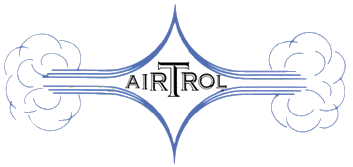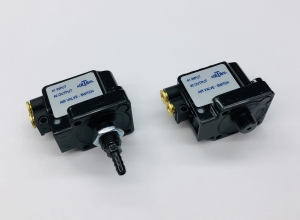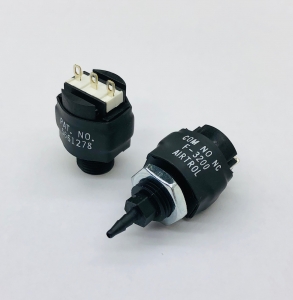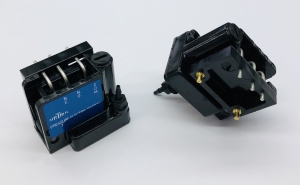SWITCHES
At Airtrol Components Inc., we’ve provided quality precision miniature pneumatic components for over 40 years. One of our core product offerings is pressure switches, which are available in numerous variations to suit different pneumatic system applications.
If you’re looking for quality pressure switches for your pneumatic systems, the experts at Airtrol Components are here to help! We offer miniature pneumatic pressure switches that are ideal for use in light- to medium-duty applications where size, weight, and precision are a concern. For more information on these products, visit the product pages or contact us today. To order parts, check out our local distributors and international distributors.
PP-700 SERIES AIR VALVE – SWITCH
The 700 Pressure Series is a pilot actuated pressure valve with a precision adjustable pilot setpoint. Perfect for use in applications which require intrinsic safety, pneumatic sequencing, and precise pressure relief. Four mounting styles are available for design flexibility. Valves can be ordered as normally open or normally closed and pilot actuation can be factory preset.
VP-700 SERIES AIR VALVE – SWITCH
The 700 series is a pilot actuated pressure valve with a precision adjustable pilot setpoint. Perfect for use in the applications which require intrinsic safety, pneumatic sequencing, and precise pressure relief. Four mounting styles are available for design flexibility. Valves can be ordered as normally open or normally closed and pilot actuation can be factory preset.
AT-1004 LOW PRESSURE FACTORY PRE-SET PRESSURE SWITCH
The AT-1004 series of low pressure switches is designed for applications where adjustability is not required. Available preset from 1.5 to 17 inches of water column. Applications include liquid level sensing, confirmation of system pressure and footpedal interfacing. Contact an Airtrol Application Engineer with your requirements.
F-3000 SERIES SUBMINIATURE PRESSURE SWITCH
The F-3000 Series pressure to electric switch is designed to meet the strictest space limitations. This unique pressure switch is constructed of chemical resistant and heat stable material. Factory pressure settings from 3 to 50 psi, for extended life, higher setpoints can be attained for devices not requiring extended life. A variety of mounting options and port connections make the F-3000 Series an excellent choice for the O.E.M.
F-4000 & F-4000X SERIES ADJUSTABLE DEADBAND SWITCHES
The F-4000 Series pressure and vacuum switches are unique in that both the actuation and release points can be set independently of each other. Available in pressure ranges to 60″ WC and vacuum to 15″ Hg. Gold contacts and solid state hall effect switch options are also available.
F-4200 SERIES PRESSURE SWITCH
The F-4200 Series pressure to electric switch is designed for the customer with cost and space limitations, and is available in adjustment ranges from .5 to 100 PSI full scale. Four mounting styles, plus a wide variety of options including gold contacts, factory pre-set and special deadbands, make the F-4200 series an excellent choice for the O.E.M.
F-4200X SERIES VACUUM SWITCH
The F-4200-X series vacuum to electric switch is designed for the customer with cost and space limitations, and is available in adjustment ranges from 4″ WC to 30″ Hg full scale. A wide variety of options including gold contacts, factory pre-set and special deadbands, make the F-4200-X series an excellent choice for the O.E.M.
F-4300 SERIES LOW DEADBAND PRESSURE SWITCH
The F-4300 series pressure to electric switches are designed for applications requiring narrow operating deadband. They are available in adjustment ranges from 2 to 100 psi full scale. Four mounting styles, plus a wide variety of options including gold contacts, factory pre-set, and solvent bonded barbed fittings, make the F-4300 series an excellent choice for the O.E.M.
F-4300X SERIES LOW DEADBAND VACUUM SWITCH
The F-4300 series pressure to electric switches are designed for applications requiring narrow operating deadband. They are available in adjustment ranges from 2 to 100 psi full scale. Four mounting styles, plus a wide variety of options including gold contacts, factory pre-set, and solvent bonded barbed fittings, make the F-4300 series an excellent choice for the O.E.M.
F-4400 SERIES PC BOARD MOUNT PRESSURE SWITCH
The F-4400 series pressure to electric switches are designed for P.C. board mount applications and are available in adjustment ranges from 2 to 100 psi full scale. A wide variety of options including gold contacts, factory pre-set and solvent bonded barbed fittings, make the F-4400 series an excellent choice for the O.E.M.
Quality Air Pressure Switches at Airtrol Components Inc.
Pressure switches are an important element of many fluid systems—both hydraulic and pneumatic. They are a type of switch that relies on fluid pressure to control the operation of connected devices and systems. After a specific pressure limit has been set, a mechanism connects or separates electrical contacts within the switch once it has been reached.
This action opens or closes an electric circuit to start or stop the flow of power into the load. Whether contact connection or separation occurs on pressure rise or pressure fall depends on the switch design.
These elements are found in a wide range of fluid systems for a variety of industries and applications, including automobiles, HVAC systems, and pumps. They come in different designs and sizes, ranging from mechanical to electronic, small to medium to large, and more.
Types of Pressure Switches
Pressure switches can be categorized into two main types: mechanical and electronic.
Mechanical
Mechanical pressure switches measure pressure changes through mechanical means, such as by using a diaphragm, piston, or Bourdon tube. The key advantages of these switches are their reliability and ability to operate without an auxiliary power source. They also offer higher voltage and amperage capacities than electronic switches.
Electronic
Electronic pressure switches measure pressure changes through electronic means—i.e., electronic pressure sensors. The key advantages of these switches are their flexibility, stability, and longevity. Various parameters can be individually adjusted to suit different applications, and the output parameters remain precise through the component’s service life. Some variations—solid-state switches—produce analog signals proportional to the pressure, which enables them to control connection/separation as well as transmit the pressure value.
What Is An Air Pressure Switch?
An air pressure switch is a pressure switch that actuates in response to air (pneumatic) pressure. They are used to control pneumatic devices and systems with strict operating pressure requirements, such as exhaust systems, fans, fire protection dampers, sound alarms, and ventilation ducts.
Components of Pressure Switches
While pressure switches can vary in design depending on the type, manufacturer, and intended application, they typically feature the following components:
- Terminals. The incoming and outgoing power wires are connected to the pressure switch at the terminals.
- Contacts. The contacts are conductive components that complete the electrical circuit when connected, allowing power to flow to the connected load.
- Diaphragm. The diaphragm—also referred to as the membrane—is a flexible component that moves in response to pressure changes. When the set pressure limit is reached, it connects or separates the electrical contacts.
- Adjustment spring(s). The adjustment spring is used to increase or decrease the on/off pressure range for the switch. Some pressure switches have a secondary adjustment spring that allows for the adjustment of the cut-off pressure setting without altering the cut-in pressure setting.
Selection Considerations for Pressure Switches
There are many factors to consider when selecting a pressure switch for a fluid system to ensure it works as intended, which can make it difficult or daunting when the time comes to choose a new or replacement component. Some of the main considerations to keep in mind include:
- Diaphragm size. The diameter of a diaphragm determines its sensitivity and, in turn, its scale. The larger the diaphragm, the more sensitive it is to changes in pressure. The smaller the diaphragm, the less sensitive it is to changes in pressure. Compared to small diaphragms, large diaphragms also provide wider scale increments and smaller deadbands.
- Setpoint. The setpoint is the pressure level at which a switch opens or closes the contacts. It can be preset at the factory by the supplier or set in the field. It can also be adjusted using the adjustment springs.
- Deadband. Deadband is the pressure difference between the setpoint and the reset point. Pressure switches with narrow deadbands are ideal for safety applications, while pressure switches with wider deadbands are suitable for control circuit applications. Typically, mechanical switches with diaphragms or Bourdon tubes have narrow deadbands, mechanical switches with pistons have wide deadbands, and solid-state switches have close to full-scale deadband.








